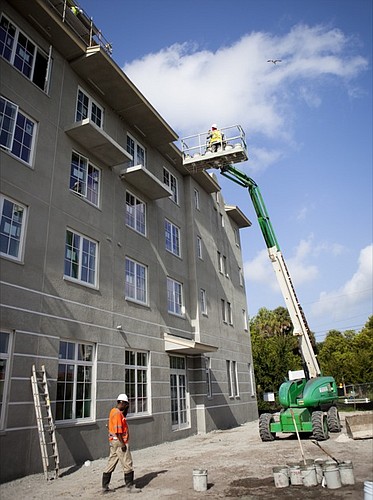- July 26, 2024
-
-
Loading

Loading

The Gulf Coast construction industry may feel a bit squeezed in the coming year as contractors work between continuing financing challenges for new developments and higher prices for building materials.
But that doesn't mean building will grind to a halt, with planned private projects taking the place of speculative development. Activity is expected for health care and education facilities as well as other types of buildings where demand has been pent up for the last few years.
“We think health care will continue to be a fairly robust marketplace,” says Alan Bomstein, president and CEO of Creative Contractors Inc., based in Clearwater. He notes that capital planning for projects stalled with the recession in 2008, but has improved in the latter months of 2010 and that momentum should carry over into 2011.
Swedish contractor Skanska USA Building Inc. has benefited from medical support projects, including several associated with the University of South Florida. Sticking with health care-related projects helped stabilize its local operations.
“We're lucky that we didn't get beaten up too badly in the downturn,” says Fred Hames, senior vice president at Skanksa's Tampa office. “We were able to hold on to all our people.”
One such example is the recent groundbreaking of Wesley Chapel Medical Center, a 200,000-square-foot hospital being built on 52 acres near State Road 56 and Bruce B. Downs Boulevard. The project is being built jointly by Florida Hospital, Adventist Health System and University Community Health over the next two years, starting with 80 beds with the capacity to expand to 300.
Although Creative Contractors is not connected with that project, Bomstein has remained actively involved in the boards of directors for BayCare Health System and Morton Plant Mease Hospitals. That helped generate business for his firm at a time when other contractors have had to suffer through the worst downturn in modern times, he says.
An ongoing freeze on capital availability is still taking its toll on the construction industry as banks continue to recover from faulty real estate loans in the last decade, adds Tom Fronce, senior vice president with Creative Contractors. “They're just requiring so much equity now,” he says. “The pendulum swung so far the other way.”
Adding to that is the rising cost of construction materials, though the sluggish economy has kept those increases to a minimum lately. Prices rose only 0.5% in November, though they remain 4.6% higher than a year ago, according to a report by Associated Builders and Contractors Inc.
The largest increases are in non-ferrous wire and cable, up at least 14% from the past year, and softwood lumber, up 5.5%. Yet prices have stabilized for other materials and supplies such as asphalt, plumbing fixtures, fabricated metal and concrete.
“Profit margins for construction contractors remain under pressure, and the data suggests they will remain under pressure for some time to come,” says Anirban Basu, chief economist for Arlington, Va.-based ABC. However, the ongoing recovery should result in less rapid increases in commodity prices in general, he says.
Private owners of commercial buildings are moving ahead with their projects after waiting for the economy to improve, says Page McKee, senior vice president and general manager of the Tampa regional office of Hardin Construction Co. The Atlanta-based contractor is currently working on an office/warehouse project in Pinellas County.
“If you're an owner, now is a great time to build,” McKee says. Along with value pricing for most building materials, he points to a greater abundance of available talent in the form of subcontractors who are eager to work.
Besides health care facilities, Bomstein says he expects to see more building activity in the coming year in higher education, municipal and not-for-profit agency projects.
McKee also foresees greater activity for multifamily projects than any other sectors of commercial real estate. Projects that had been placed on hold for a while are expected to get under way in the coming year, he says.
“There is some new demand for rental property,” he says. “We could see some apartment projects released in 2011.”
Data from the Florida Economic Estimating Conference indicates multifamily starts should more than double over the coming year, from 6,800 to 13,000, while total construction expenditures are expected to rise nearly 8% from $26.7 billion to $28.8 billion. Private non-residential expenditures are expected to remain stable at just above $6 billion.
The conference also reports single-family construction starts are expected to increase over the year from 27,200 to 42,600, even with a continuing overhang of existing foreclosed homes. Contractors say they do not expect any similar building activity with condominiums or townhomes.